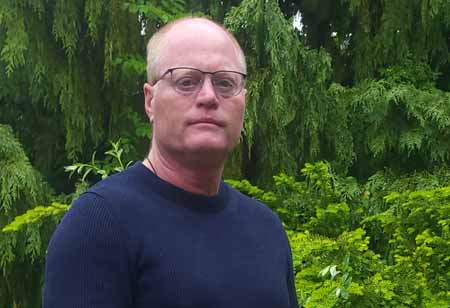Thank you for Subscribing to Construction Business Review Weekly Brief

Strategies for Successful Brownfield Construction and Risk Management
Scott Dumville began his career at JNE immediately after graduating, starting as a civil/structural engineer in training. He initially supported brownfield plant maintenance projects at a steel producer in Hamilton, Ontario, working closely with operations and maintenance teams. With significant freedom to develop solutions and engage directly with clients and construction partners, Scott built a strong understanding of plant personnel needs and installation challenges. Building on this foundation, he progressed to discipline design leader, managing larger capital projects. After a decade of field-focused experience collaborating with construction, operations and maintenance, Scott transitioned into project management. He now leads engineering teams to deliver practical, clientfocused solutions.
Insights on Brownfield Construction and Risk Management
The most critical aspect of brownfield construction is the time spent on site and engaging with people who truly understand the area. Tools like 3D scanning can help reduce interference, but the best asset is a company who has knowledge and is familiar with the plant’s philosophy, history, and personnel. Partnering with an experienced engineering firm, rather than relying on competitive bidding, leads to better outcomes. This is something that runs contrary to common practice. A lack of internal knowledge or site review can cause planning issues, extending construction durations or resulting in impractical designs that aren’t supported by operations. This can be true with both small and large projects, although larger projects do tend to have more owner resources assigned and inherently more planning.
The best asset is a company who has knowledge and is familiar with the plant’s philosophy, history, and personnel
In the steel industry, outages are typically inflexible because maintaining production is crucial to uphold supply contracts. Any disruption could result in substantial financial losses for the company. Therefore, after ensuring safety, continuous production is prioritized, even if it requires additional upfront costs. During the planning phases, it is common for steel owners to mandate redundancy planning for critical systems to ensure that production can continue in case of unexpected events. Typically, the objective is to balance the lowest possible construction cost with the need to maintain an optimal overall technical solution while mitigating risks.
My company’s standard practice on large capital projects is to perform a risk analysis jointly with construction partners and the plant project team part way through the project design. One important consideration when planning the work to be performed during an outage is to maintain flexibility in case the outage gets rescheduled, the duration changes or unexpected discovery items during the outage cause delays. The upfront costs associated with a diligent application of a risk analysis will be less than potential unplanned expenses or lost profits resulting from these risks.
Planning and Execution in Live Operating Environments
The first step in planning brownfield work is to figure out what work can be done during operations and what work requires outages. Where possible, in a continuous operation, we use a preliminary outage to install a bypass of some sort to allow as much work to take place during operations as possible to reduce downtime. During an outage, it is crucial to have immediate access to experienced site engineering support to collaborate effectively with the contractor and owner’s representatives. This collaboration is essential to minimize construction delays due to unforeseen issues arising during the construction process. I have spent many nights in a trailer during outages to ensure timely resolution of any issues, and I generally remain quite busy in such situations.
For optimal efficiency, it is essential for the project team to function as a cohesive unit prioritizing the project’s interests. Establishing a strong project team culture is crucial, especially in today’s virtual environment where it can easily be overlooked. Our company prefers hiring recent graduates and assigning them small brownfield plant engineering projects, which provide the necessary framework and mindset to provide the support mentioned above.
Local standard practices are sometimes only discovered when a contractor is hired. I have had several noteworthy experiences in my career, including designing a water treatment plant in Mexico. During this project, I had to resize a concrete cold well for a cooling tower as the local contractors preferred increasing its size rather than cutting plywood sheets. Another experience was in Ukraine, where foundations are installed in pyramid shapes instead of the conventional pier and footings approach which affected locations of underground utilities.
We generally prefer to engage with local partners to help us understand local practices as well as help with permitting and code interpretations specific to the project site. It’s good to know what the local constraints are as well.
The lesson that travels well across borders is to always remember that your best partners are the ones who know the plant. Ultimately, engineers depart once a project is finished, whereas the local operator and maintenance teams must live with the final installation. Therefore, sometimes the easiest engineering solution may not necessarily be the most appropriate one. I consistently remind my team that our decisions must be guided by the best interests of the project. By doing so, we ensure that all companies involved in the installation are treated equally and fairly.
JNE fosters a culture of field work, emphasizing consistent on-site presence and direct collaboration with contractors during construction. Additionally, JNE prioritizes prompt responses to site RFIs to ensure the continuity of construction activities.
One of the core values of our company and a key focus in developing the JNE engineering team is integrity. Although fostering integrity can be challenging, once established, it is recognized and valued by the project team. It is common for individuals to avoid confrontation by not being entirely truthful when errors occur. However, people can usually sense a lack of honesty, even if they cannot identify the exact cause.
We maintain a long-term workforce, which is rare in consulting engineering. Many colleagues from my start date remain at JNE 27 years later. Our priority is root cause analysis and continuous improvement over fault assignment. We demand integrity and respect in interactions with clients and projects, and this is usually reciprocated in the steel industry.
Brownfield work requires a lot of planning and a focused approach to risk elimination and/or mitigation. Where schedule allows, the owner should do a basic engineering stage to define how to proceed safely with installation during operation and outage durations. When possible, the owners should engage local construction partners in this early-stage planning. These two activities will help develop the basis for the planned construction sequencing and should not fundamentally change as the planning gets further detailed. Performing a constructability and risk analysis assessment to the base installation plan will minimize the chance of change and maximize the likelihood of a successful project.








